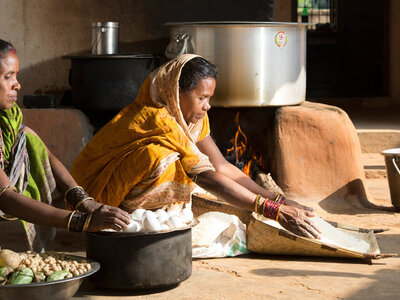India
- 67%
- of children are affected by anaemia
- 10%-plus
- of people live on less than US$2 a day
- 1.4 billion
- population
As the world's most populous country, India has enjoyed steady economic growth and has achieved self-sufficiency in grain production. Despite this, high levels of poverty, food insecurity and malnutrition persist. According to official estimates, anaemia affects 57 percent of women and 67 percent of children.
According to the recent report of National Family Health Survey-5 (2019-21), the nutrition indicators for children under 5 show stunting (impaired development due to malnutrition) at 35.5 percent, wasting (low eight for height) at over 19 percent and prevalence of underweight at over 32 percent.
Over 10 percent of people live on less than US$2 a day, and levels of inequality and social exclusion are very high. In 2023, India’s GDP per capita was over US$9,000, among the highest in South Asia but lower than other major economies.
The World Food Programme (WFP) has been working in India since 1963, transitioning from food distribution to technical assistance since the country achieved self-sufficiency in cereal production in the late 1980s. With the Government now responsible for food distribution, we support the strengthening of this work so systems become more efficient and food assistance reaches the people who need it most.
What the World Food Programme is doing in India
-
Transforming the targeted public distribution system
-
WFP is working to improve the efficiency, accountability and transparency of India’s own subsidized food distribution system, which brings supplies of wheat, rice, sugar and kerosene oil to around 800 million poor people across the country. WFP ensures that food reaches those who need it most, working with the Government to reform and strengthen the system, which is one of the world’s largest.
-
Fortification of government-distributed food
-
To boost the nutritional value of the Government’s Mid-Day Meal school meals programme, WFP is pioneering the multi-micronutrient fortification of school meals. The pilot project saw rice fortified with iron, which was distributed in a single district, resulting in a 20 percent drop in anaemia. We also help tackle malnutrition by fortifying food given to babies and young children in the southwestern Kerala State.
-
Food insecurity mapping and monitoring
-
WFP uses its own Vulnerability Analysis and Mapping software to identify India’s most food-insecure areas, which allows policy and relief work to be targeted appropriately. WFP is also supporting the government’s Poverty and Human Development Monitoring Agency in establishing a State-level Food Security Analysis Unit, working towards the goal of achieving zero hunger.
India news releases
Go to pagePartners and donors
Find out more about the state of food security in India
Visit the food security analysis pageOperations in India
Contacts
Office
World Food Programme, 2 Poorvi Marg, Vasant Vihar,
110057
India







